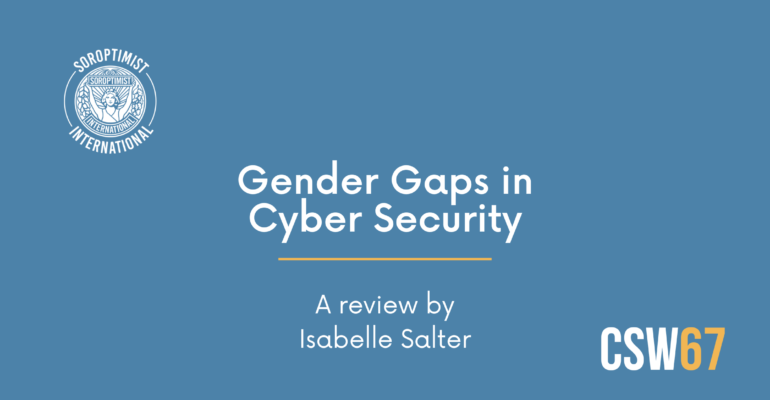The panel discussion hosted by the Alliance of NGOs on Crime Prevention and Criminal Justice, on Thursday 09 March, entitled “Gender Gaps in Cybersecurity”, aimed to analyse current issues within the cyberspace, discuss how cybersecurity failures have become a reflection of offline patterns of abuse, exclusion and discrimination, and better understand how different organisations are tackling them. The event opened with a statement from the Alliance’s Chair, Anna Alvazzi del Frate.
First to present was Isabella Wilkinson, Research Associate at Chatham House for cyber policy. Isabella’s intervention asked important questions, such as “Why does gender matter in cyber policy?”. She debunked myths by explaining that ‘gender’ within the cyberspace is not only a woman’s issue; cyber is a social issue, not just a technical one; and that gender equality does have an important place in cyber policy. Policies which reflect whole communities are better policies by recognising that different genders experience the digital world differently. Isabella called for gender mainstreaming to therefore be reflected in all cyber policy, including in the United Nations Ad Hoc Committee on Cybercrime (AHC), because, as she reflected, “cyberspace often reflects the bias, discrimination and power hierarchies that exist offline”. Isabella closed by emphasising that words and commitments will not be enough: real action is desperately needed.
Next to speak was Alison Yakabe, Lead Cyber Intelligence Analyst at San Mateo County Sheriff’s Office, who works within a joint taskforce which tackles cybercrime. Alison highlighted specific cases her team have dealt with and emphasised that female victims of cybercrime are often sexualised, mirroring the ways in which crime is often perpetrated against women and girls offline.
Cyberbullying among children was one of the common incidents that Alison’s team deals with (10 to 12 incidents every week). She emphasised that her police colleagues often, lack the resources, education, or appropriate training to tackle cyberbullying, meaning many of these crimes are simply not investigated. She went on to highlight how schools are key targets for cybercriminals as they provide an exploitable network which lacks resources for protection against such threats. Interestingly, Alison’s team does not separate these crimes by gender, and this made it difficult for her to give broader statistics about the impact of cybercrime on female students.
The concept of shame was raised as a key factor as to why so much cybercrime goes unreported. The perpetrator relies on the victim feeling too embarrassed to go to authorities and plays to the false conception that the victim ‘should have known better’. This was reflected in all the cases Alison raised, the first being a teenage girl having unsolicited photographs taken of her in a school changing room and subsequently shared to social media by her peers, and the second example being female social media influencers having their phones hacked and being threatened with having private photographs shared (also known as ‘sextortion’). Alison closed by noting that people are starting to report cybercrimes more frequently, and in a timely manner, which is helping the fight against cybercrime.
Last to speak was Linda Witong, a Soroptimist, member of the Alliance’s board, and member of the CSW67 Advocacy Research Group. Linda spoke in detail about the scale of cybercrime worldwide and provided harrowing statistics about the lengths criminals go to for financial gain, despite this not being their only motivation.
For the first time, the World Economic Forum has placed cybercrime and cyber insecurity in the top 10 of the most severe risks to global society over the next decade. The statistics supported this ominous prediction, demonstrating that cybercrime has grown substantially, with a 358% rise in malware and 435% increase in ransomware in 2020 alone. Linda observed that ransomware attacks on schools has risen by 827% due to them proving lucrative for cybercriminals, as schools are underprepared, mirroring the points highlighted by Alison in the previous presentation. At the heart of Linda’s presentation was the concept that as cyber attackers find more intelligent ways to perpetrate cybercrimes, the wider the gap of digital inequality becomes, and the more vulnerable communities become.
While the three presentations adopted different perspectives, from theory to real evidence, together they underscored the complex issues facing us. The cyberspace represents an opportunity for gender equality, but if we do not provide equal education opportunities to all genders, in all areas of the world, the gap could represent yet another way for women and girls to be oppressed, widening the gender gap even further.

